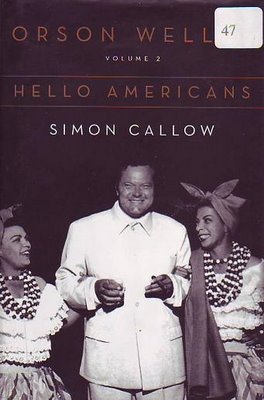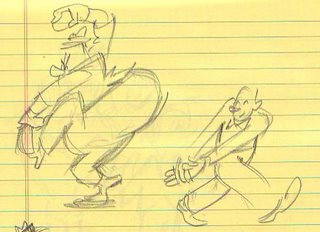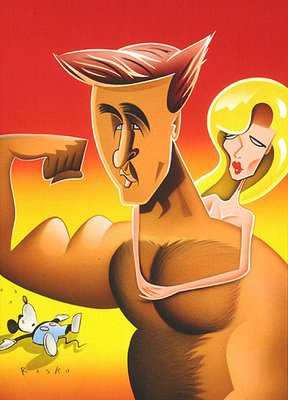 Here it is, the second volume of Simon Callow's biography of Welles. I've only just begun it so I really shouldn't be writing about it so soon. I just can't help it, there's so many interesting things in it. Please forgive my writing and probable typos. I have to write this fast with no time to edit.
Here it is, the second volume of Simon Callow's biography of Welles. I've only just begun it so I really shouldn't be writing about it so soon. I just can't help it, there's so many interesting things in it. Please forgive my writing and probable typos. I have to write this fast with no time to edit. Here's an example (above) of the kind of narrative prose Welles liked to write. I knew I'd seen the style before but I couldn't place it until now: it's from Psalm 23 in the King James Bible. In that Psalm each line is split in two: " The Lord is my shepherd / I shall not want. " It's the only poetry in the English language that might surpass Shakespeare, in fact some say that Shakespeare wrote it. Almost every line is two or three simple thoughts jammed together with a natural pause between each thought...it's a very powerfull type of prose. Very noble, very musical.
Here's an example (above) of the kind of narrative prose Welles liked to write. I knew I'd seen the style before but I couldn't place it until now: it's from Psalm 23 in the King James Bible. In that Psalm each line is split in two: " The Lord is my shepherd / I shall not want. " It's the only poetry in the English language that might surpass Shakespeare, in fact some say that Shakespeare wrote it. Almost every line is two or three simple thoughts jammed together with a natural pause between each thought...it's a very powerfull type of prose. Very noble, very musical.Shakespeare used it in the beginning of "Romeo and Juliette:" "Two houses / both alike in dignity /in fair Verona /where we lay our scene (maybe I've quoted wrong, I don't have it infront of me)." That's the way Welles wrote about the little boy and his bull: "The boy's name was Chico / and the bull's name was Bonito." Joe Fante, a heavyweight writer himself, is credited with writing the narration but you know that Welles wrote it. All his narratives sound like that. It's a beautiful way to write.
I've only read a dozen pages or so. When I put it down Callow was relating the story of how Welles rehearsed the actors in "Magnificent Ambersons." He recorded the rehearsel on records then played the best parts back when it was time to film it. Welles thought actors always spoke their lines too slow infront of the camera and he wanted to remind them how good it sounded when they spoke fast in rehearsel. Callow thought it had the unexpected effect of making the scenes feel awkward because the actors couldn't find the natural rythym of the present, infront of the camera.
Welles put a lot of emphasis on the reading that was done in rehearsel. I'm proud of myself because I deduced this before I ever read it, in fact I did a blog entry about it. You can hear it in the way he delivered his lines in " Jane Eyre." The lines sound like they're being read! You might think that would be a liability but it wasn't. It sounded great that way! I read ahead in the Jane Eyre sequence and discovered that he walked on the set and started directing from a podium just like a conducter, even though he was only hired to act.











